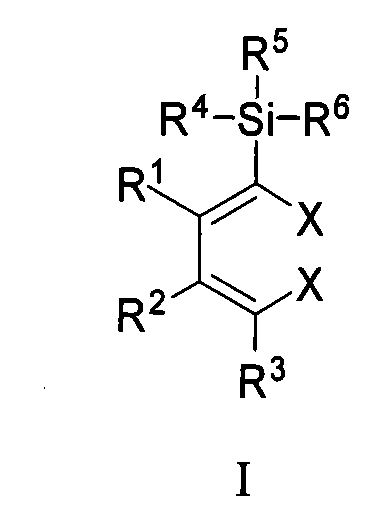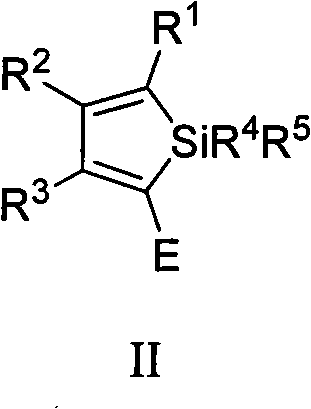Process for preparing polysubstituted silole
A polysubstituted and silole technology, which is applied in the field of organic synthesis intermediates and new functional materials synthesis, can solve the problems of lack of synthesis methods, and achieve the effects of wide application range, easy availability of raw materials and high separation yield.
- Summary
- Abstract
- Description
- Claims
- Application Information
AI Technical Summary
Problems solved by technology
Method used
Image
Examples
Embodiment 1
[0048]One of the compounds of formula IIa (R 1 =TMS, R 2 =R 3 =Ph, E=H): Synthesis of 1,1-dimethyl-2-trimethylsilyl-3,4-diphenylsilole
[0049] Add 1mmol 1,4-diiodo-1,4-bis(trimethylsilyl)-2,3diphenyl-1,3-butadiene and 5mL ether solvent to a 20mL reaction tube under nitrogen protection , add tert-butyllithium dropwise at -78°C, react for one hour after the addition, add HMPA, raise the temperature to reflux, and react for one hour with magnetic stirring. Add water (as an electrophile) to react at zero temperature, extract the water phase with ether three times, combine the organic phases, wash with saturated sodium chloride solution, add anhydrous magnesium sulfate to the organic phase after liquid separation, dry for 30 minutes, and filter under normal pressure , the filtrate was concentrated, decolorized and separated on a silica gel column, and the eluent of petroleum ether was used to obtain 300 mg of pure product 2-trimethylsilyl-3,4-diphenylsilole (purity > 95%, color...
Embodiment 2
[0051] Formula IIa class compound two (R 1 =TMS,R 2 =R 3 =Ph, E=SiPh 3 ): Synthesis of 1,1-dimethyl-2-trimethylsilyl-3,4-diphenyl-5-triphenylsilylsilole
[0052] The raw materials and synthetic route are basically the same as above. The electrophilic reagent used is triphenylchlorosilane, which is quenched by adding saturated sodium bicarbonate solution after the reaction, and the aftertreatment is the same. 500 mg of pure product (purity>98%, colorless solid, melting point: 102-104°C) was obtained with an isolated yield of 85%. The NMR and high resolution mass spectrometry data of this compound are as follows: 1 H NMR (300MHz, CDCl 3 , Me 4 Si, 25°C): δ=-0.17(s, 9H, CH 3 ), -0.01(s, 6H, CH 3 ), 6.41-6.46 (m, 2H, CH), 6.51-6.56 (m, 2H, CH), 6.84-6.86 (m, 2H, CH), 6.97-6.99 (m, 3H, CH), 7.19-7.27 ( m, 10H, CH), 7.45-7.47 (m, 6H, CH); 13 C NMR (75MHz, CDCl 3 , Me 4 Si, 25°C): δ=-3.15 (2CH 3 ), 0.68 (3CH 3 ), 125.65(1CH), 126.01(1CH), 126.29(2CH), 126.85(2CH), 127....
Embodiment 3
[0054] One of the compounds of formula IIb (R 1 =TMS, R'=H, E=H): 4,5,6,7-tetrahydro-2,2-dimethyl-1-trimethylsilyl-2H-benzo[c]silole
[0055] The synthetic route is basically the same as above, using water as the electrophile, and the post-treatment is the same. The starting raw material dihalogen compound of this synthesis is 1,2-bis-(1'-iodo-1'-trimethylsilylmethylene)-cyclohexane. 0.201 g of pure product (purity>98%, colorless liquid) was obtained with an isolated yield of 86%. The NMR and high-resolution mass spectrometry data of this compound are as follows: 1 H NMR (300MHz, C 6 D. 6 , Me 4 Si, 25°C): δ = 0.25 (s, 9H, CH 3 ), 0.26(s, 6H, CH 3 ), 1.35-1.51 (m, 4H, CH 2 ), 2.47(t, J=6.0Hz, 2H, CH 2 ), 2.55(t, J=6.0Hz, 2H, CH 2 ), 5.82(s, 1H, CH); 13 C NMR (75MHz, C 6 D. 6 , Me 4 Si, 25°C): δ=-3.76 (2CH 3 ), 0.89 (3CH 3 ), 23.79 (1CH 2 ), 24.31 (1CH 2 )32.39 (2CH 2 ), 33.10 (1CH 2 ), 128.94(1CH), 135.35(1quat.C), 159.23(1quat.C), 165.65(1quat.C); HRMS cal...
PUM
 Login to View More
Login to View More Abstract
Description
Claims
Application Information
 Login to View More
Login to View More - R&D
- Intellectual Property
- Life Sciences
- Materials
- Tech Scout
- Unparalleled Data Quality
- Higher Quality Content
- 60% Fewer Hallucinations
Browse by: Latest US Patents, China's latest patents, Technical Efficacy Thesaurus, Application Domain, Technology Topic, Popular Technical Reports.
© 2025 PatSnap. All rights reserved.Legal|Privacy policy|Modern Slavery Act Transparency Statement|Sitemap|About US| Contact US: help@patsnap.com



